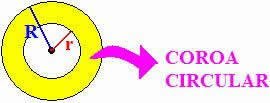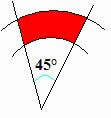Consider a circle inscribed on another circle, that is, two concentric circles (same center), the flat region delimited by them is called a circular crown.
See illustrations below:
Thus, we will have two radii: one from the largest circumference and one from the smallest.
From the figure we can say that the area of the circular crown will be equal to the difference in the area of the two circles that form the crown:
THEcrown = Abigger circle - Asmaller circle
THEcrown = (π. R2) - (π. r2)
THEcrown = π. (R2 - r2)
Example: Determine the colored surface area:
AC = AO/2
AO = 10
As the colored region is 1/4 of the circular crown, we will have to divide the total area of the crown by 4:
THEcolorful = π (R2 - r2)
4
THEcolorful = π (152 - 102)
4
THEcolorful = π (225 – 100)
4
THEcolorful = π 125
4
THEcolorful = 125π cm2
4
Example: The colored region in the figure below is 32 π/25 m2 of area. If the radius of the arc measures 4m, how much is the radius of the smallest?
360°: 45° = 8, this means that the painted part corresponds to 1/8 of the circular crown, so we can say that the crown will have an area equal to:
THEcrown = 32 π/25. 8 = 256 π / 25
To find out the value of the smallest radius, just apply the formula and make the necessary substitutions:
THEcrown = π. (R2 - r2)
256 π / 25 = π. (42 - r2)
256 π / 25 = π. (16 - r2)
10.24 = 16 - r2
10.24 – 16 = – r2 (-1)
-10.24 + 16 = r2
5.76 = r2
2.4 = r
by Danielle de Miranda
Graduated in Mathematics
Brazil School Team
Spatial Metric Geometry - Math - Brazil School
Source: Brazil School - https://brasilescola.uol.com.br/matematica/area-coroa-circular.htm
